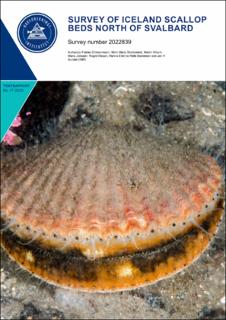| dc.contributor.author | Zimmermann, Fabian | |
| dc.contributor.author | Stokkeland, Mimi Maria | |
| dc.contributor.author | Wiech, Martin | |
| dc.contributor.author | Jenssen, Maria | |
| dc.contributor.author | Olssøn, Ragni | |
| dc.contributor.author | Danielsen, Hanna Ellerine Helle | |
| dc.contributor.author | Sundet, Jan Henry | |
| dc.date.accessioned | 2024-02-08T10:57:17Z | |
| dc.date.available | 2024-02-08T10:57:17Z | |
| dc.date.created | 2024-02-07T11:28:08Z | |
| dc.date.issued | 2023 | |
| dc.identifier.uri | https://hdl.handle.net/11250/3116354 | |
| dc.description.abstract | In August 2022, the scallop beds of Moffen and Parryflaket north of Svalbard were surveyed to assess the state and distribution of Iceland scallops (Chlamys islandica). This represented the first investigation in 30 years after the closing of the scallop fishery in the area, following several years of destructive overfishing. The survey was conducted with video transects inside and outside the protected areas, and dredge stations outside the protected areas parallel to video transects. Dredging was used to collect biological samples for size and age composition, and tissue samples for contaminant, nutrient and population genetic analysis. Furthermore, parallel stations allowed to compare observed scallop densities between dredge and video. Still images were extracted from video to annotate scallops, with repeated annotations of all stations by multiple persons. The results show that the stocks on both scallops bed have recovered from previous fishing to densities that are comparable or higher than those observed in the Bear Island area. The scallop abundance at the two scallop beds combined is estimated to be higher than on the three Bear Island scallop beds, whereas the scallops on Moffen and Parryflaket tended to be smaller and therefore the proportion above minimum legal landing size lower. Geostatistical approaches were tested to estimate density and abundance. Compared to previous design-based approaches, spatial modelling captures the spatial variation in density more adequately, allows for including links to habitat and environment, and to estimate uncertainty of estimates. Furthermore, video and dredge data could be integrated into a joint estimate, improving the resolution and historic comparability. We recommend to consider the inclusion the scallop beds north of Svalbard into the trial fishery to spread fishing effort across a larger stock and area. Toktnummer: 2022839 | |
| dc.description.abstract | Survey of Iceland scallop beds north of Svalbard - Survey number 2022839 | |
| dc.language.iso | eng | en_US |
| dc.publisher | Havforskningsinstituttet | en_US |
| dc.relation.ispartof | Toktrapport | |
| dc.relation.ispartofseries | Toktrapport;2023 - 17 | |
| dc.relation.uri | https://www.hi.no/hi/nettrapporter/toktrapport-en-2023-17 | |
| dc.title | Survey of Iceland scallop beds north of Svalbard - Survey number 2022839 | en_US |
| dc.title.alternative | Survey of Iceland scallop beds north of Svalbard - Survey number 2022839 | en_US |
| dc.type | Research report | en_US |
| dc.description.version | publishedVersion | |
| dc.source.pagenumber | 37 | en_US |
| dc.source.issue | 2023 - 17 | en_US |
| dc.identifier.cristin | 2243985 | |
| cristin.ispublished | true | |
| cristin.fulltext | original | |
